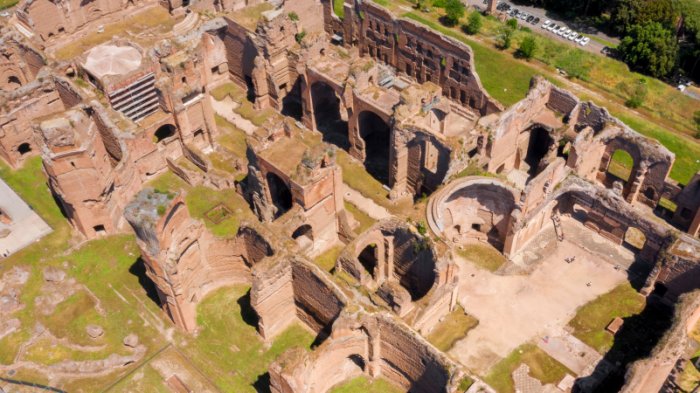A. Sutherland – AncientPages.com – The Baths of Caracalla are undoubtedly among imperial Rome’s most ambitious architectural masterpieces.

Aerial view of Baths of Caracalla. Credit: Adobe Stock – Stefano Tammaro
Their name relates to the Roman Emperor Marcus Aurelius Antoninus from 198 to 217 AD, better known by his nickname ‘Caracalla. ‘The Baths of Caracalla are the second largest (after the Baths of Diocletian) but they represent most complete bathing complex in Rome.
His colossal baths, located in the south of Rome, were not only the emperor’s famous achievement but also represented a unique world where the Roman society enjoyed entertainment and intellectual debates and was busy concluding business contracts. They could relax and spend their free time caring for both the body and the spirit in the baths.
Even though all residents had to pay for the use of the baths, the fee was not high, and it was worth paying to enjoy comfortable bathing.
This facility was the largest swimming pool, which, in addition to many swimming pools, consisted of spaces for various sports and social gatherings of the Rome’s citizens.

Ruins of the Baths of Caracalla in Rome. Credit: Abobe Stock – Only Fabrizio
Emperor Caracalla commissioned the monumental bathhouse complex in the years 211-216. However, it is believed that Emperor Septimius Severus initiated the construction of the baths, which was later completed during the reign of his son, Caracalla.
At the time of the construction, it was the second largest thermal complex in Rome, second only in size to the Trajan’s Thermae (‘Terme di Traiano’), which is today in ruins.
For five years, usually, about 9,000 laborers were involved in the complex’s construction every day. The thermal baths – extended with several additional structures during the reign of Emperor Alexander Severus – functioned for almost 300 years.
Impressive Architecture Of The Caracalla’s Baths
The thermal baths of Caracalla had about 250 columns, and more than 6,000 cubic meters of the finest building materials like granite and marble were used to decorate the interiors.
Symmetry Dominated The Baths Of Caracalla
The vast bath complex was arranged symmetrically along the great hall with the four doors leading to the vestibule, changing rooms, and then into the gyms, a series of rooms for diverse physical activities.

Athletes mosaics from the Baths of Caracalla. Beautiful mosaics covered the floors of the floors of the public libraries located on the east and west sides of the bath complex. Image source
It is ᴀssumed this place could accommodate up to 1,500 -1,600 bathers simultaneously, and about 8,000 Romans pᴀssed through the complex daily.
The bath complex covered approximately 25 hectares (62 acres). The complex is rectangular, measuring 337 m × 328 m. Its construction involved the moving of a substantial amount of earth, as parts of the nearby hills had to be removed or leveled into platforms. Several million bricks were used in the construction.
The water used to power the pools and attractions was taken mainly from the nearby Aqua Marcia aqueduct. The water was collected in cisterns located in the southern part of the thermal baths. It is estimated that the cistern could hold about 8,000 liters of water, which was then heated using a wood-burning stove. To ensure the optimal temperature in the pools throughout the day, about 1 ton of wood was used to burn.
The exterior and interior of the baths were richly decorated. Even today, there are still well-preserved fragments of water fountains, statues, sculptures, floor mosaics, and marble pieces, once part of the building’s decoration.
Rooms With Many Functions
The complex consisted of more than 20 rooms, some of which were the most important and popular.

Ruins of the Baths of Caracalla. Credit: Adobe Stock – Marek Poplawski
The first was the ‘caldarium,’ a circular pool with warm water (unfortunately, this one no longer exists.) Another was the ‘tepidarium’ (medium-temperature room), and the next was the ‘frigidarium, a rectangular pool of cold water decorated with beautiful sculptures. Popular and frequently visited was also an Olympic-sized swimming pool called the ‘Natatio.’ All these spaces were the central part of the baths’ complex.
They were surrounded by smaller rooms, such as locker rooms or two gymnasiums built for physical exercise rooms). A roof, except for the palestra, closed most of the rooms. The palestra was the place for people interested in wrestling and boxing exercises.
The two large rooms at the corners were used as libraries, one for Greek language texts and one for Latin language texts. The surviving library had three walls covered by 32 niches that housed the books.
Written by – A. Sutherland – AncientPages.com Senior Staff Writer
Copyright © AncientPages.com All rights reserved. This material may not be published, broadcast, rewritten or redistributed in whole or part without the express written permission of AncientPages.com





